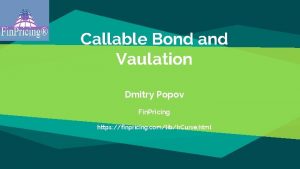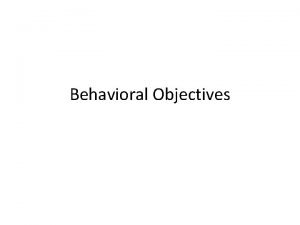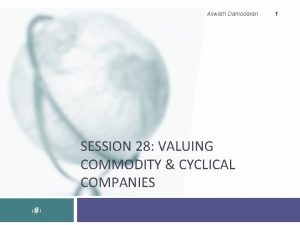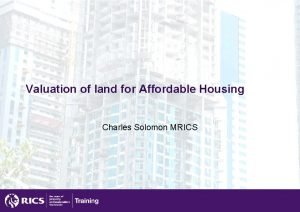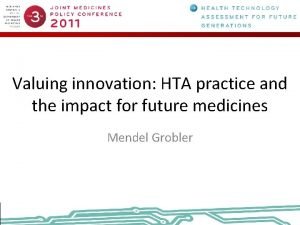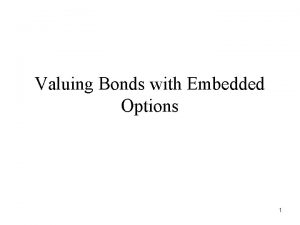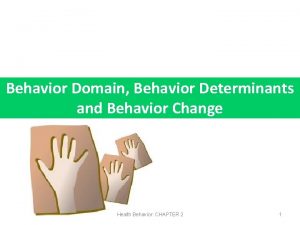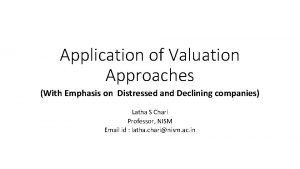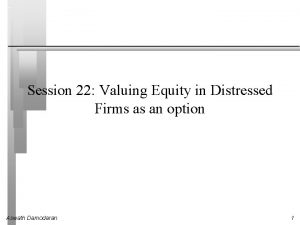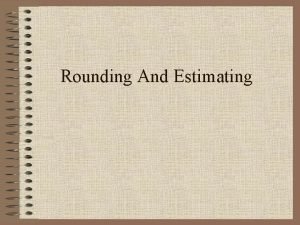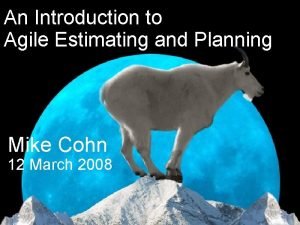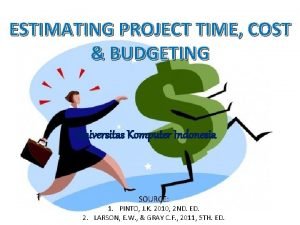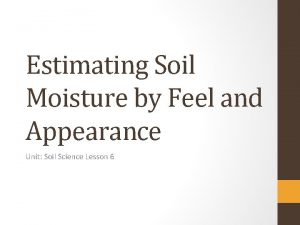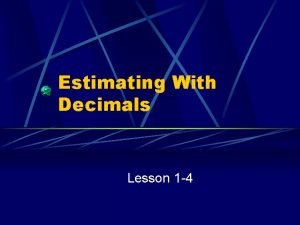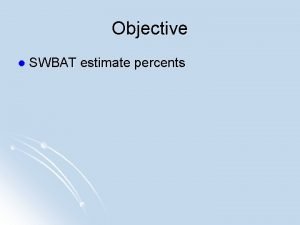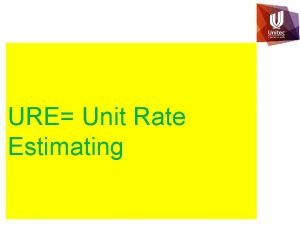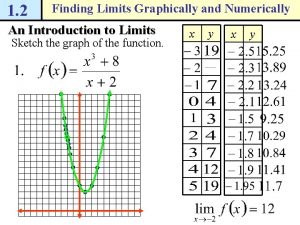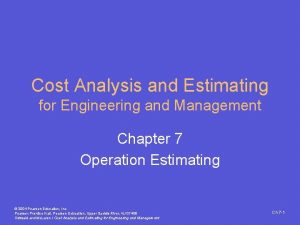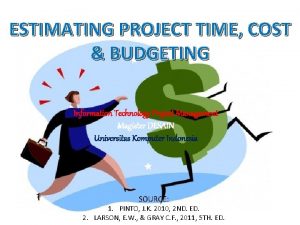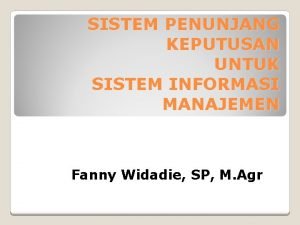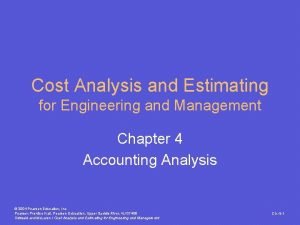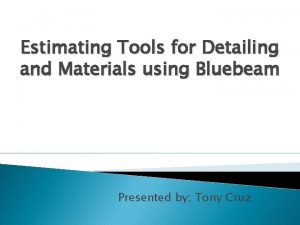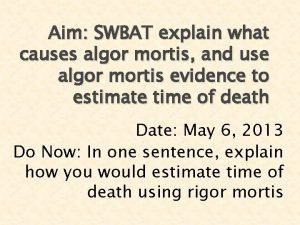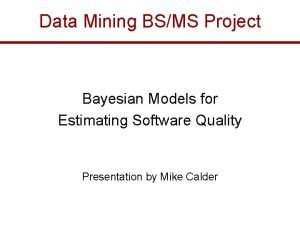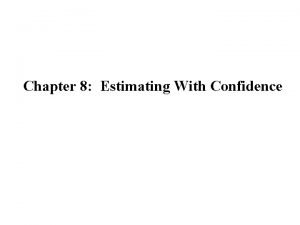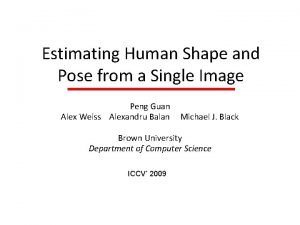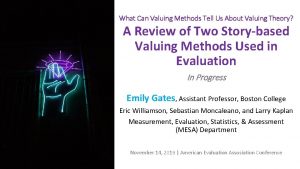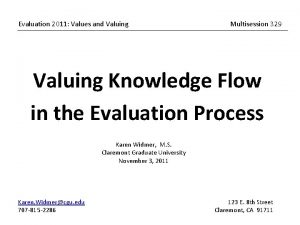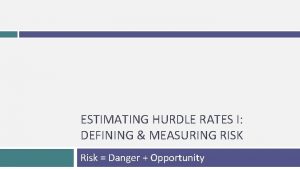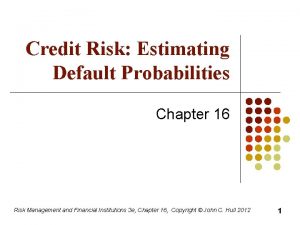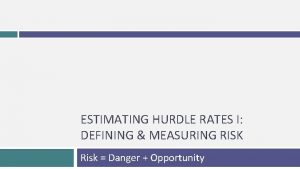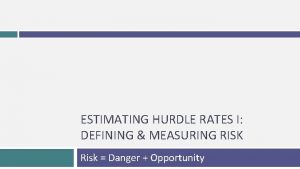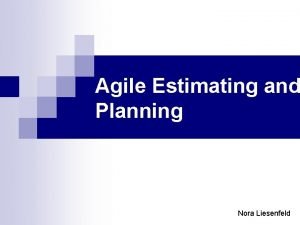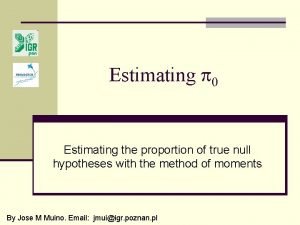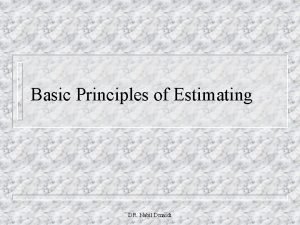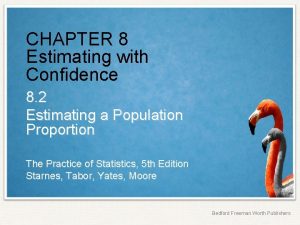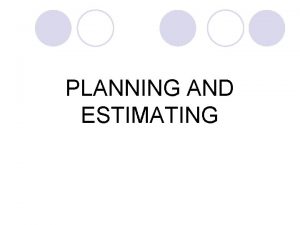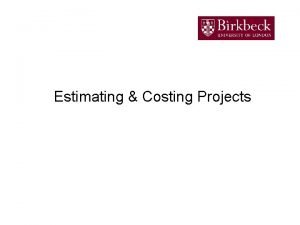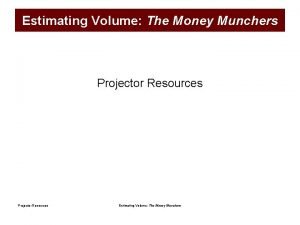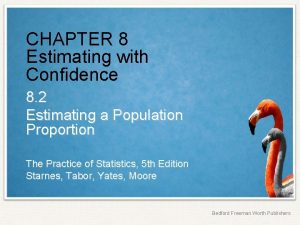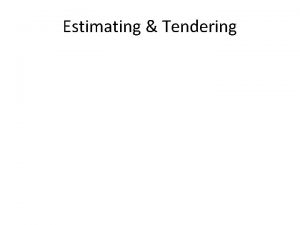WP 5 Valuing what is at risk estimating





















































- Slides: 53

WP 5: Valuing what is at risk, estimating impacts and evaluating management options Palm Protect: Final project meeting, Gran Canaria, 19 th Nov, ‘ 14

Acknowledgement • Many thanks to all Palm Protect project partners and collaborators who searched for data regarding pest outbreaks, management action taken and costs incurred. Your help and advice has been much appreciated. • Help is still needed to complete the last 2 deliverables

Outline – Economic impacts • WP 5 - delivery schedule • Progress since last project meeting • What we need to do to complete the WP

Delivery schedule - original plan No. Deliverable Project month D 5. 1 Report describing the economic market for palm products D 5. 2 Report describing the ecosystem services provided by amenity palm planting, with examples of the value of some services 18 D 5. 3 Report estimating the potential socioeconomic impacts caused under given scenarios 24 D 5. 4 Report estimating the change in future impacts by implementing new control measures and management strategies 36 D 5. 5 Identification of costs: benefits of management strategies 36 6

Delivery schedule - revised plan No. Deliverable Project month D 5. 1 Report describing the economic market for palm products D 5. 2 Report describing the ecosystem services provided by amenity palm planting, with examples of the value of some services 18 D 5. 3 Report estimating the potential socioeconomic impacts caused under given scenarios 31 D 5. 4 Report estimating the change in future impacts by implementing new control measures and management strategies 36 D 5. 5 Identification of costs: benefits of management strategies 36 6

Progress summary (i) • Since Sicily meeting (May’ 14) Mapping establishment area • Draw on review of host literature (WP 2) & other host information • Review other modelling approaches • Climate change scenarios Economic modelling of impacts (base line study) • Case study countries • Expert input of parameters

Potential distribution • Knowledge of area under threat informs the magnitude of impact • Can use of modelling systems to identify areas suitable for establishment • Using information from WP 2 has helped inform identification of area for establishment • Shows integration between project WPs

Mapping establishment area • To estimate impacts need to have an idea of potential area for pest establishment • Previous feed back from partners suggested RPW would occur where hosts were found i. e. range limited by host distribution • WP 5 examined this

Environmental suitability: hosts • Hosts – use information from WP 2 • Although R. ferrugineus has many “hosts” in Europe, most significant damage occurs on only two; Phoenix canariensis and P. dactylifera • Both are restricted to southern Europe, in plant hardiness zones 9, 10 and 11

Plant hardiness zones • Plant hardiness zones are based on average annual minimum temperatures and are a way to categorize locations suitable for winter survival of plants

Environmental suitability: hosts

Area by country EU countries containing plant hardiness zones 9, 10 or 11, with the percentage of 0. 5 o latitude x 0. 5 o longitude grid cells in each zone. EU MS Malta Portugal Cyprus Greece Italy Spain France Ireland Zones not suitable for Phoenix canariensis or P. dactylifera Zones 1 -8 22. 6 32. 7 66. 3 71. 2 77. 8 93. 8 98. 0 Zones most suitable for P. canariensis and/ or P. dactylifera Zone 9 Zone 10 Zone 11 Sum 9 -11 100. 0 67. 6 67. 3 33. 7 22. 1 21. 3 6. 2 2. 0 9. 5 6. 7 0. 9 - 0. 2 - 77. 3 67. 3 33. 7 28. 8 22. 2 6. 2 2. 0

Environmental suitability - RPW • Having identified areas most suited to primary hosts WP 5 then examined the areas where climate is most suitable for R. ferrugineus development • Allows areas at risk to be identified, and consequences estimated

Previous studies • 3 earlier studies predicted RPW distribution

Fiaboe et al. (2012) Niche modelling Summary of ecological niche model projections based on the known occurrences of R. ferrugineus globally. Ramp scale from white (unsuitable) to red (highly suitable). Source: Fiaboe et al. , (2012)

Zhou et al. (2012) CLIMEX Predicting RPW distribution in Asia Zhou, Zhang, Ren & Hang (2012)

Zhou et al. (2012) parameters applied to Europe

Ji et al. (2013) CLIMEX Areas that suit development of RPW: light grey to black (least to most suitable)

Current distribution RPW distribution in Asia, North Africa & Europe

Current distribution RPW distribution in Asia, North Africa & Europe + hardiness zones

WP 5 estimate (CLIMEX)

WP 5 estimate (CLIMEX) Approximate distribution of R. ferrugineus marked by circles.

WP 5 estimate (CLIMEX) WP 5 estimate focussed into the Euro-Mediterranean region.

WP 5 estimate with irrigation WP 5 estimate focussed into the Euro-Mediterranean region.

Climate change scenarios • Shabani et al. (2013) used CLIMEX software to show the potential distribution of P. dactylifera under current and various future climate scenarios for Spain

Date palm distribution Source: Shabani et al. (2013)

RPW current climate + irrigation WP 5 estimate focussed into the Euro-Mediterranean region.

RPW future climate + irrigation WP 5 estimate focussed into the Euro-Mediterranean region.

Conclusions (RPW) 1 • R. ferrugineus is fairly well established in some coastal areas around the Mediterranean (inc. Egypt and Israel) but there is still considerable scope for more spread • Primary Phoenix hosts are limited to coastal southern areas, but some potential hosts are more frost tolerant and if they turn out to be true hosts northwards spread of pest is likely • Climate change will support further spread of hosts and pest

Conclusions (RPW) 2 • This work confirms experts opinions that R. ferrugineus is likely to be able to establish in areas where hosts plants flourish • Areas not yet infested by R. ferrugineus are therefore vulnerable to damage by the borer • Concern about future damage supports reasons for investment in research seeking effective tools and mechanisms to better manage and control the pest.

Paysandisia archon • Not as well studied as not an economically important plant pest in South America • WP 2 (Rochat et al. , 2014) provided useful review of its occurrence in Europe, hosts, life cycle and biology from literature. • In France, Italy and Spain, most often harms Trachycarpus fortunei, Chamaerops humilis and P. canariensis

Paysandisia archon Hosts Plant hardiness zones for true P. archon hosts Palm Common name Grows in hardiness zones Chamaerops humilis Mediterranean Fan Palm 8 - 11 Phoenix canariensis Canary Island Palm 9 - 11 Trachycarpus fortunei Windmill Palm 8 -11 Butia capitata Pindo Palm Tree 8 - 11 Syagrus romanzoffiana Queen Palm 9 - 11

European plant hardiness zones Zone 8

EFSA study – P. archon Distribution of Paysandisia archon in Europe. Map by Sarto i Monteys & Aguilar (2005) updated with information from (EFSA, 2014).

Paysandisia archon • No detailed modelling by WP 5 due to … - lack of detailed information about the distribution of P. archon - lack detailed of information on response to climatic parameters • Given lack of data such modelling would be inappropriate (as per guidance by Baker et al. , 2012).

Economic impact

Economic impact • Due to variability of detail with the information obtainable, WP 5 developed reasonable scenarios to describe areas of establishment and the socio- economic impact that occurred in case study countries • Developed model for pest spread (radial & satellite generation) • Socio-economic impacts estimated within current area and the area occupied in next 10 years

Economic impact • Complex spread model based on spread model published previously (Cook et al. , 2006) • Many input parameters • WP 5 began with estimates based on data in literature or expert opinion • Shared with contacts in case study countries for feedback (Spain, Italy, Greece & France) • These are the worst affected EU countries

Spread model parameters •

Complex spread model Area infested Satellite generation Number of infested palms at an outbreak Economic impact due to eradication effort, replacement cost and ecosystem services

Data • Spread: parameters vary between case study countries due to differences in climate, composition and distribution of hosts used expert opinion e. g. growth rate, population densities, flight range • Cost: parameters vary due to differences in action taken (regional variation), little data freely available; most detailed used for the purpose of solidarity payments and EU surveys • Lost ESS: literature based, but very limited

Economic impact (NPPO) • NPPO costs to implement the current EU emergency measures (surveillance and inspection to monitor spread in infested sites and demarcated buffer zones) • Destruction / treatment of infested palms • Preventive chemical treatments within and around 200 metres of the infested sites

Economic impact (other) • Replacement cost and value of ecosystem services provided by palms • Based on market information and published studies

However: not all costs included • Not all ecosystem services which are lost when palms are infested and destroyed are included in calculations - energy saving from shading - wind shelter provided - aesthetic and cultural value

Not all costs included • Palms that fall can kill people • Impact estimates are therefore conservative (low estimate)

Cumulative impacts to 2013 (€ millions)

Cumulative additional impacts to 2023 (€ millions)

D 5. 3 Potential impacts • Developed scenarios that describe areas of establishment and the socio- economic impact that can be expected over next 10 years • Provides a base line for comparison in scenarios where new management methods are used

Final work • Having established base line (D 5. 3) … • Aim is to next represent new detection & monitoring (WP 3) and management options (WP 4) in model e. g. revise likelihood of detection & change diffusion • So now needs estimates of how implementing new methods will alter pest spread • Use new parameter estimates in spread model to estimate new costs (D 5. 4) • Compare base line with new options (D 5. 5)

Next steps (D 5. 4) • A simple description of each method near to being applied in practice • Comment on the methods improved efficacy versus current practice

Next steps (D 5. 4) • With such information, WP 5 will develop a set of scenarios and assumptions modifying model parameters • Check these estimates against expert opinion • Then rerun the model for case study countries so as to assess the effect of using new methods

Finally (D 5. 5) • Comparison of D 5. 3 with D 5. 4 gives a type of cost: benefit analysis

Thank you
 Market risk credit risk operational risk
Market risk credit risk operational risk Factual inquiry in ethics
Factual inquiry in ethics Bloom's taxonomy affective domain
Bloom's taxonomy affective domain Valuing culture
Valuing culture Resoect quotes
Resoect quotes Vaulation
Vaulation Psychomotor objectives examples
Psychomotor objectives examples Valuing cyclical companies
Valuing cyclical companies Valuing land for social housing
Valuing land for social housing Valuing innovation
Valuing innovation Effective duration formula
Effective duration formula Domain behavior
Domain behavior Valuing distressed and declining companies
Valuing distressed and declining companies Valuation of ip
Valuation of ip Valuing a private company
Valuing a private company Valuing distressed companies
Valuing distressed companies Triumvirate rome
Triumvirate rome Risk projection attempts to rate each risk in two ways
Risk projection attempts to rate each risk in two ways Business risk audit
Business risk audit Risk map risk management
Risk map risk management Ar = ir x cr x dr
Ar = ir x cr x dr Risk financing retention adalah
Risk financing retention adalah Risk avoidance insurance
Risk avoidance insurance Business vs financial risk
Business vs financial risk Population attributable risk formula
Population attributable risk formula Absolute risk vs relative risk
Absolute risk vs relative risk The biggest risk is not taking any risk
The biggest risk is not taking any risk Relative risk calculation
Relative risk calculation Activity sheet 2 to risk or not to risk
Activity sheet 2 to risk or not to risk Key risk indicators for vendor management
Key risk indicators for vendor management Relative risk
Relative risk Residual risk and secondary risk pmp
Residual risk and secondary risk pmp Medium risk examples
Medium risk examples Rounding and estimating decimals
Rounding and estimating decimals Agile estimating and planning by mike cohn
Agile estimating and planning by mike cohn Bottom up estimating
Bottom up estimating Estimating soil moisture by feel and appearance
Estimating soil moisture by feel and appearance Estimating with decimals
Estimating with decimals Estimating percents
Estimating percents Ccwfel
Ccwfel Alberto rode 5/8 of the water rides at a water park
Alberto rode 5/8 of the water rides at a water park Lesson 2 understanding limits graphically and numerically
Lesson 2 understanding limits graphically and numerically Concrete construction estimating
Concrete construction estimating Cost analysis and estimating for engineering and management
Cost analysis and estimating for engineering and management Is 256 a perfect square
Is 256 a perfect square Mii cost estimating
Mii cost estimating Normal vs expedited costs
Normal vs expedited costs Voyage estimating decision support system
Voyage estimating decision support system Cost analysis and estimating for engineering and management
Cost analysis and estimating for engineering and management How to insert a checkmark in bluebeam
How to insert a checkmark in bluebeam Algor mortis worksheet
Algor mortis worksheet Mining estimating software
Mining estimating software Chapter 8 estimating with confidence
Chapter 8 estimating with confidence Pose
Pose





